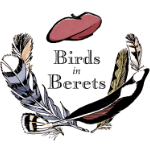
Tiny, Fearless, and Very Vocal; suggested by Will K.
A Good Neighbor & A Good Friend
Birds in Berets was still a very new project when I asked Will to think up a bird suggestion. We were at a weekend-long conference for artists of all sorts, and I was already a little weary from a panel discussion I had been asked to contribute to at the last minute. That has to have been why I instantly forgot having asked. Will didn’t forget, and on Monday morning he was ready with his request. “I think it has to be a Carolina Wren. I see them quite a bit.”
Indeed, if you have the pleasure of living near a nesting pair of Carolina Wrens, there’s almost no way to avoid seeing them often and up-close. They are utterly fearless and quite social. As I prepared to paint this little wren in his blue beret, I realized that Carolina Wrens have a lot in common with Will himself. He’s tenaciously loyal and a gregarious talker, willing to be busy every moment of the day to take care of his family and friends. He’s an ambitious and apparently fearless illustrator, but is also deeply committed to his friends’ and colleagues’ success. And he’s a redhead–just like this Carolina Wren.
So, now I’m curious: do you see yourself in your favorite birds? Or gravitate towards ones that you want to be like? Eventually I’ll tell the reasons behind my choice of Celeste for my own studio mascot, but that will probably be when I do an article like this one on Black-capped Chickadees. In the meantime, make sure to add a comment at the bottom of this post if there’s a bird that reminds you of yourself or a friend!
Carolina Wrens In Real Life
Carolina Wrens are one of the most engaging and personable of the Eastern U.S.’s backyard bird species. They have short, round bodies, large heads with almost no neck, long beaks, and slender tails cocked up at a jaunty angle. The males defend a huge territory with constant singing and occasional hearty scolding. Unlike their cousins the House Wrens, female Carolina Wrens aren’t known to sing, but will still duet with their mates by adding their own busy chattering or shrill, ascending or descending call notes to his complicated bursts of song. Mating pairs may bond at any time of year, and will mate for life, residing year-round in their breeding territory and raising two or three broods of feisty nestlings every year. The oldest recorded wild Carolina Wren was at least seven years and eight months old, living in Florida and recaptured several times in the same area where he was originally banded.
Pairs of Carolina Wrens will move quickly and actively through their territory, preferring to hop or fly short distances through dense, ground-level cover. The majority of their diet is made up of insects, which they find by rummaging in leaf litter and poking their heads into the crevices of trees, fences, buildings, or really anything within their reach. They’re absolutely fearless in their constant exploring, and view any object, natural or artificial, as fair game for perching, nest material, or foraging. The same applies to their choice of nest site. While scientists claim that in their wild habitat they prefer cavities in trees, they’re well known for building in mailboxes, propane tank and utility box covers, disused flowerpots, in-use planters and hanging baskets, boots and shoes, and whatever else you’ve left outside. This season a pair raised two broods in a row in a hanging basket directly outside my parents’ front door, tolerating my mother’s daily watering with surprising cheerfulness. Reports vary as to their tolerance for human disturbances, with some birders and gardeners viewing them as overly aggressive and a nuisance. In my own experience, those who chose to nest near an area where humans are frequently present have been quite companionable–even allowing me to admire their eggs or nestlings–whereas any I’ve surprised in an out-of-the way spot have scolded loudly and chased me from the area.
The Carolina Wren’s range has steadily expanded northward since 1900, but particularly harsh winters take a toll on the northernmost population. Since they don’t migrate, they have to rely on steady access to open ground and an adequate supply of insects and seeds near the surface. Research has been done to find out whether temperature or food scarcity is the more pressing concern for the northernmost Carolina Wrens, but early data is inconclusive. Preliminary conclusions suggest that the little birds’ active metabolism might be able to overcome the cold weather as long as food with adequate protein and fats are available. This suggests that no matter where you live, you might see more Carolina Wrens in the winter by offering a feeder with suet or peanuts in a sheltered spot.
Carolina Wren Identification
Like all wrens, Carolinas are easy to spot at a distance because of their uniquely round, chunky body and lack of pronounced neck. Their beaks are as long as their heads, and curve slightly downward. In Carolina and House Wrens, look for a vigorously twitching or noticeably upward-cocked tail and rounded wingtips that extend beyond the bird’s rump like the tails of a tuxedo. Carolina Wrens are the larger of the two cousins, and sport vivid red-brown feathers on their backs and heads with a buff-yellow belly. They’re especially easy to identify by their long, white eyebrow stripe, which gives them a determined or self-satisfied expression. House Wrens are a close cousin, but their upper- and underparts are much more similar in color, and without the noticeable white eyebrow they tend to look more unimpressed than cocky. For aural I.D., the easiest approach is often to listen for duet singing: female House Wrens use an interwoven, musical song that often matches so well that it sounds like a complicated song from a single bird, while female Carolina Wrens have a signature rhythmic chattering.
Welcoming Your Own Wren Family
If you’re just beginning to make your yard or garden a habitat for local birds, a Carolina Wren box can be a great way to start. They’re one of the easiest birds in the U.S. to entice with suitable nesting spaces, and one of the most delightful creatures to watch as they take up residence and raise a family. Properly speaking, you can become a landlord to Carolina Wrens without much effort at all–usually forgetting to tidy something away after the gardening season is all it takes. However, since male wrens sometimes defend their nesting space by darting around an intruder’s head and shrieking loudly, you can improve your own experience of your new tenants by putting in a little extra thought.
The best wren homes mimic naturally-occurring tree cavities. Despite being tiny themselves, Carolina Wrens prefer a spacious entrance slot about 2 1/2″ high and positioned close to the top of the box. Since that’s a large opening, you’ll have to find some way of denying access to larger bird species that might prey on wren nestlings or lay parasitic eggs. Wren nests are surprisingly large (and wren nestlings surprisingly rowdy), so the inside of the box needs to be around a 6″ in each dimension, with the largest dimension (if there is one) being from top to bottom. Once you have your ideal nest box, you’ll want to place it out in February or early March, in advance of nesting season. Location is important–wrens like to stay under dense cover and near the ground, so attach your box to a building or fence near some bushy landscaping or forest understory. Remember that you’ll be sharing the space with some active and vocal little creatures, too–under bedroom windows, near plants that have to be tended daily, or next to high-traffic doors or pathways will be fine for wrens, but could create an inconvenient summer for the humans in your life! Finally, your new wren friends will want to stake out a territory roughly the size of a football field, which means you’ll probably only be able to squeeze one nest box in your yard (though if you happen to have two or more suitable spots at least 110 yards apart, feel free to add more)!
Several great conservation and birding groups offer great free nest box patterns. I’ve collected a short list of options for you here.
Once you’ve attracted a family of Carolina Wrens, consider other ways to care for them: maintaining some areas of dense shrubs or tangled perennials, raking fallen leaves to the base of trees and bushes for mulch instead of discarding them, and keeping a small brush pile for fire kindling and compost are all ways to bring your new friends comfort and make sure they can feed their chicks plenty of insects all summer and into the autumn. If you live someplace where winter involves days or weeks of snow-covered ground, you can also set out a feeder with suet or peanuts to make sure they stay healthy and full.
Character Design
I actually took a lot of liberties with this little Carolina Wren. My goal with his design was to convey the bluster self-assurance of a male inspecting his territory, so I leaned hard into his pose. With most Birds in Berets, I find myself enlarging the character’s head, but in this one I emphasized the thrust-out chest and alert shoulder joints. This effectively made his head smaller than it is in real life. To balance this, his eye is much larger relative to his head and beak. I wanted to emphasize the tilt of his tail, too–I could have done that by angling it higher, but it turned out to be more effective to align it with the angle of the lower legs, creating a diagonal line that crosses the whole drawing and adds visual energy. The bars on his rump are slightly exaggerated and the pattern of feathers on his wings is all but non-existent in most real wrens. For his hat, I wanted to reference the signature look of another blustering bird, Disney’s Donald Duck. While I didn’t go in for the contrasting colors and jaunty ribbon, I feel like the maritime blue, the taller brim, and the deep crease in the crown do a reasonable job conjuring up a Donald vibe.
More About Carolina Wrens
Many conservation and birding groups provide great free patterns for Carolina Wren nesting boxes. Here are links to a few:
From Cornell Lab’s Nest Watch project. Cornell Lab has access to a lot of data from citizen birdwatchers like us, so their pattern is based on the preferences of the majority of Carolina Wrens.
From Nestbox Builders birdhouse plans database. I like that they thought to use the front panel as the removable access panel, but would have liked it to be hinged rather than screwed into place.
From 70 Birds birdhouse plans database. This focuses on step-by-step instructions that go beyond construction and into proper maintenance and cleaning, but be aware that the dimensions are more to the taste of bluebirds or house wrens.
For more on Carolina Wren I.D. and a great library of Wren vocalizations, check out the Audubon Field Guide

